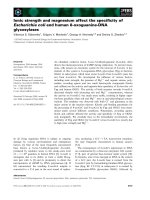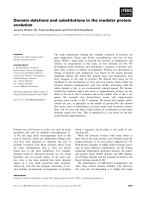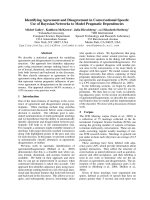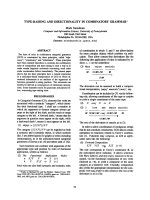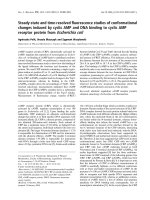Báo cáo khoa học: Adipocyte hyperplasia and RMI1 in the treatment of obesity doc
Bạn đang xem bản rút gọn của tài liệu. Xem và tải ngay bản đầy đủ của tài liệu tại đây (120.17 KB, 5 trang )
MINIREVIEW
Adipocyte hyperplasia and RMI1 in the treatment
of obesity
Akira Suwa, Takeshi Kurama and Teruhiko Shimokawa
Drug Discovery Research, Astellas Pharma Inc., Ibaraki, Japan
Introduction
Obesity is a complex disorder and a major risk factor
for metabolic diseases such as type 2 diabetes mellitus,
hypertension and cardiovascular disease. Obesity devel-
ops as the result of an imbalance between energy
intake and expenditure. To state simply, chronic reduc-
tion of energy expenditure versus intake causes an
increased storage of the excess energy in the form of
intracellular triacylglycerol droplets in adipose cells,
leading to an increased fat mass and ultimately result-
ing in obesity.
Adipocyte hyperplasia (increase in cell number) and
hypertrophy (increase in cell size) are thought to be
directly responsible for the observed increase in adi-
pose tissue mass [1,2]. Adipocyte hypertrophy in par-
ticular is considered the main cause of adult obesity,
and hyperplasia of adipocytes in obese adults some-
times occurs secondary to adipocyte hypertrophy, pos-
sibly due to an increased number of adipocytes
capable of secreting paracrine growth factors that
induce adipocyte hyperplasia [3].
Whereas the basic number of adipocytes is estab-
lished during childhood and adolescence in both
humans and rodents, adipose tissue retains the ability
to generate new adipocytes throughout life. Increased
adipocyte number during aging has been implicated in
the rising incidence and severity of obesity among the
elderly [4]. Thiazolidinediones, a class of oral antidia-
betic agents, are nuclear receptor peroxisome prolifera-
tor-activated receptor gamma agonists which enhance
generation of small-sized adipocytes by inducing adi-
Keywords
adipocyte hyperplasia; adipogenesis; cell
cycle; obesity; E2F; energy homeostasis;
high-fat diet; metabolic disorders; RMI1;
therapeutic target
Correspondence
A. Suwa, Pharmacology Research Labs,
Drug Discovery Research, Astellas Pharma
Inc., 21 Miyukigaoka, Tsukuba-shi, Ibaraki
305–8585, Japan
Fax: +81 29 852 5391
Tel: +81 29 863 6417
E-mail:
(Received 26 July 2010, revised 29
November 2010, accepted 3 December
2010)
doi:10.1111/j.1742-4658.2010.07980.x
The escalating prevalence of obesity is one of the most pressing health
concerns of the modern era, yet existing medicines to combat this global
pandemic are disappointingly limited in terms of safety and effectiveness.
The inadequacy of currently available therapies for obesity has made new
drug development crucial. In the past several decades, however, major pro-
gress has been achieved in understanding adipocyte hyperplasia associated
with the pathogenesis of obesity, and consequently new potential targets
for the medical treatment of obesity have been identified. We primarily
review recent progress in the regulation of adipocyte hyperplasia as a novel
emerging nontraditional approach. In this minireview, we focus on recQ-
mediated genome instability 1 (RMI1), a recently identified novel molecular
target for obesity treatment. RMI1-deficient mice have been found to be
resistant to high-fat diet- and genetics-related obesity. Expression of this
protein is regulated by E2F transcription factors, and recent studies have
suggested that RMI1 plays an important role in the control of energy
homeostasis during the development of obesity, with a mode of action
based on the regulation of adipocyte hyperplasia.
Abbreviations
A
y
, lethal yellow agouti; BLM, Bloom’s syndrome gene; E2F, E2F transcription factor; RB, retinoblastoma protein; RMI1, recQ-mediated
genome instability 1; Skp2, S-phase kinase-associated protein 2.
FEBS Journal 278 (2011) 565–569 ª 2010 The Authors Journal compilation ª 2010 FEBS 565
pogenesis, resulting in increased adipose tissue mass
and thereby obesity [5].
This growing body of evidence suggests that adipo-
cyte hyperplasia may be a key event in the develop-
ment and subsequent clinical course of some types of
obesity. In this minireview, we focus on adipocyte
hyperplasia as a novel therapeutic target for the treat-
ment of obesity and discuss the merits of targeting
recQ-mediated genome instability 1 (RMI1), a recently
identified energy homeostasis-related molecule, for
obesity treatment.
Adipocyte hyperplasia
Preclinical studies have demonstrated that adipocyte
hyperplasia occurs in two steps: an increase in num-
bers of preadipocytes, followed by the differentiation
of preadipocytes into mature adipocytes. The transi-
tion process from proliferation to differentiation in the
adipocyte is tightly regulated by interaction between
the cell-cycle regulators and the differentiating factors,
and creates a cascade of events leading to the commit-
ment of cells into the adipocyte phenotype [6,7].
This process, described as ‘adipogenesis’, requires a
specific sequence of events to unfold, including growth
arrest of proliferating preadipocytes, coordinated
re-entry into the cell cycle with a limited clonal expan-
sion, and growth arrest before terminal differentiation
during lipid accumulation, suggesting that some
cross-talk occurs between the cell cycle or the cell
proliferation machinery and the factors controlling cell
differentiation.
Cell-cycle regulation
The factors involved in cell-cycle regulation clearly
fulfill important roles in the cell proliferative phase of
adipocyte hyperplasia. Cell-cycle progression in mam-
mals is governed at each phase of the cell cycle by
various complexes of cell-cycle-related molecules,
including cyclins, cyclin-dependent kinases, their inhib-
itors and the retinoblastoma protein (RB), as well as
E2Fs.
E2F and RB family members appear to participate
in the regulation of cell-cycle events that are required
for adipogenesis. In growth-arrested preadipocytes, for
example, E2Fs are complexed with pRB, leading to
repression of its target genes [8]. Upon re-entry into
the cell cycle by these growth-arrested preadipocytes,
RB is phosphorylated by cyclin ⁄ cyclin-dependent
kinase holoenzymes, releasing the E2F complex and
thereby resulting in activation of the E2F target genes
[9]. Fajas et al. [10] demonstrated that the E2F protein
family plays a central role in preadipocyte proliferation
and that E2F1-deficient mice are resistant to obesity
induced by a high-fat diet (due to suppression of fat
mass accumulation).
Cyclin-dependent kinase inhibitors include two fami-
lies of proteins, the Cip (Kip) family and Ink4 family,
and are central players in the exit of cells from the cell
cycle [11]. Loss of p27
Kip1
or p21
Cip1
in mice leads to
adipocyte hyperplasia as a result of increased prolifera-
tion or recruitment of preadipocytes [12], suggesting
that these cyclin-dependent kinase inhibitors are
important in the regulation of adipocyte number.
The S-phase kinase-associated protein (Skp)1–Cullin-
F-box protein (SCF) ubiquitin ligase (E3) complex
targets cyclin-dependent kinase inhibitors for degrada-
tion by the 26S proteasome and thereby regulates cell
cycle progression [13]. Sakai et al. [14] showed that a
deficiency in Skp2, the substrate-binding subunit of the
SCF
Skp2
complex, contributes to the degradation of
p27
Kip1
, resulting in an induced resistance to obesity
due to inhibition of preadipocyte proliferation without
causing adipocyte hypertrophy. Such results were
observed in both high-fat diet- and lethal yellow agouti
(A
y
) gene-induced obesity models. Similarly, other
cell-cycle-related molecules such as cyclin-dependent
kinase [15,16] and RB [17] have also been shown to
play an important role in cell proliferation during
adipogenesis.
The above-mentioned findings strongly suggest that
cell-cycle regulation associated with adipocyte hyper-
plasia may present a novel approach to treating obes-
ity. However, any cell-cycle modulation could
potentially affect not only metabolic tissue, but normal
tissues as well. Indeed, Skp2-deficient mice have shown
a reduced number of b cells in the pancreas [14].
In addition, overexpression of p27
Kip1
in b cells
induced hyperglycemia in mice as a result of inhibition
of b-cell proliferation [18]. These potentially serious
adverse effects associated with nonspecific inhibition of
cell proliferation may pose a major obstacle for clinical
use of this approach in obesity therapy.
RMI1 and obesity
Using a random mutagenesis approach based on the
exchangeable gene trap method, we recently identified
RMI1 as a novel regulator of energy homeostasis [19],
which was reported to be an essential component
of Bloom’s syndrome protein complexes [20], although
no evidence had linked it to energy homeostasis until
our findings. RMI1, an enzyme-binding protein, has
previously been reported to mediate DNA recombina-
tion, chromosome organization and biogenesis, as well
Adipocyte hyperplasia and RMI1 A. Suwa et al.
566 FEBS Journal 278 (2011) 565–569 ª 2010 The Authors Journal compilation ª 2010 FEBS
as to regulate cell-cycle checkpoint machinery [21].
RMI1 is also a member of Bloom’s syndrome gene
(BLM)–topoisomerase complex; targeted mutations of
BLM are developmentally delayed and die off by
embryonic day 13.5 [22,23] and RMI1 homozygous
knockout embryos die due to an unknown cause [19].
Bloom’s syndrome is a rare recessive genetic disorder
characterized by dwarfism, telangiectatic erythema,
immune deficiency and a predisposition towards devel-
oping cancer [24,25].
RMI1 heterozygous knockout mice (RMI1+ ⁄ ))
have a phenotype almost identical to that of the wild-
type, although body weight and fasting-plasma glucose
are significantly lower in wild-type mice. However,
RMI1+ ⁄ ) mice possess a number of striking features
that render them resistant to metabolic diseases. When
fed a high-fat diet, the mutant mice were not only
resistant to obesity, they showed improved glucose
intolerance and reduced abdominal fat tissue mass.
In addition, the mutants were also resistant to obesity
induced by the A
y
gene. Of particular note is the fact
that the deficient mice showed a rate of weight gain
and amount of food intake equivalent to measurements
taken under normal diet conditions. Taken together,
these results indicate that RMI1-deficient mice can
grow normally despite developing basal abnormalities,
suggesting that the impact of RMI1 deficiency is sensi-
tive and limited to developing obesity [19]. However,
we cannot exclude the possibility that slight basal
changes such as lower body weight and as yet unidenti-
fied abnormalities can partially affect the energy
balance. Future studies are needed to clarify whether
RMI1-deficient mice exhibit a BLM-like phenotype.
RMI1 and cell-cycle regulation
The mode of action of RMI1 in the regulation of
energy homeostasis might be based on the regulation of
adipocyte hyperplasia. Studies have shown that siRNA
knockdown of RMI1 resulted in suppression of cell
proliferation [24]. However, RMI1 expression is upreg-
ulated in the abdominal fat tissue of obese and diabetic
mice, which show adipocyte hyperplasia, suggesting
that RMI1 may be associated with the development of
lipid accumulation in metabolic tissues, thereby leading
to obesity [19]. We recently observed that treatment
with glucose increased RMI1 expression in adipocyte-
derived cell lines. Intriguingly, both mRNA levels of
E2F5 and E2F8 increased on treatment with glucose,
as seen with RMI1, and siRNA knockdown of these
genes suppressed RMI1 expression. In addition, com-
puter analysis has shown evidence of E2F response ele-
ment consensus sites in the RMI1 promoter (Suwa A,
Kurama T, Shimokawa T and Aramori I, unpublished
observations), suggesting that E2F may transactivate
the promoter. Taken together, these results indicate
that RMI1 expression can be regulated by E2F family
molecules in adipose tissue under high-glucose condi-
tions, influencing preadipocyte proliferation.
RMI1 as a novel target for obesity
treatment
Recent studies in vivo and in vitro have demonstrated
that RMI1 plays an important role in the regulation of
energy homeostasis via an interaction with E2F path-
ways, at least in part, suggesting the involvement in
the regulation of adipocyte hyperplasia. RMI1 expres-
sion is induced by glucose in vitro, and its in vivo
expression is also induced by metabolic abnormalities
such as hyperglycemia and obesity in metabolic tissues
such as liver and adipose tissues.
However, targeting RMI1 may not affect whole-body
proliferation, because changes in RMI1 expression in
metabolic disorders are restricted to metabolic tissues;
indeed, RMI1-deficient mice have not shown any
abnormalities in nonmetabolic tissues. More impor-
tantly, the in vivo evidence of anti-obesity effects was
obtained from RMI1 heterozygous mice, suggesting
that a 50% reduction in RMI1 level would be sufficient
to treat energy homeostasis disorders. Recent advanced
findings about RMI1 suggest that RMI1-targeting is a
helpful therapeutic approach to treating energy homeo-
stasis disorders such as obesity, leading to an encourag-
ing increase in research focusing on drug discovery of
RMI1 expression modulators. However, several unan-
swered questions remain regarding the effects of RMI1
on the regulation of energy homeostasis. First, RMI1
deficiency suppresses high-fat diet-induced upregulation
of E2F8 in vivo [19]. By contrast, RMI1 expression is
actually regulated by E2F8 expression in vitro,as
described above. These reports permit us to speculate
regarding the positive feedback regulation between
RMI1 and E2F on cell proliferation. In addition, E2F8
has been reported to reduce rather than induce cell pro-
liferation [26,27]. Given the disparity in findings, eluci-
dation of E2F8’s functions and contribution to the
regulation of cell proliferation will require numerous
future experiments. Second, RMI1 deficiency signifi-
cantly reduced food intake only under conditions of
excess of energy input [19]. In addition, RMI1 expres-
sion was significantly increased in the hypothalamus
under high-fat feeding conditions and decreased under
fasting conditions [19]. These results suggest the possi-
bility that RMI1 might directly regulate feeding behav-
ior via the central nervous system, which has crucial
A. Suwa et al. Adipocyte hyperplasia and RMI1
FEBS Journal 278 (2011) 565–569 ª 2010 The Authors Journal compilation ª 2010 FEBS 567
roles in the control of energy metabolism, leading to
body weight reduction. Further investigations to clarify
the each contribution of adipocyte and central effects
on the regulation of energy homeostasis such as using
the brain- or adipose tissue-specific RMI1 conditional
knockout mice would be required.
Conclusions
Obesity develops as a result of the disruption of the
homeostasis between food intake and energy expendi-
ture, and therefore factors affecting these processes are
the focus of extensive research targeting the develop-
ment of effective anti-obesity drugs. To date, however,
only limited success has been achieved in this endeavor
[28], highlighting the need for additional therapeutic
options. Recently, interesting novel approaches and tar-
gets for obesity treatment have been reported, many of
which have been cited in the other minireviews in this
series. One such approach is the concept of central regu-
lation, focusing on the malonyl-CoA pathway [29],
while another approach uses the adipocyte-derived
inflammatory mediator [30]. However, here we focus on
a recently identified novel approach involving adipocyte
hyperplasia, differing clearly from both the central and
inflammatory approaches. Given that a number of
molecular causes have been implicated in the develop-
ment of obesity, combining these different approaches
likely represents the most effective treatment method.
Excessive calorie intake associated with hyperphagia
and ingesting a high-fat diet in mice results in storage
of the extra energy, initially through an increase in adi-
pocyte size. However, as adipocytes have a limited
capacity for enlargement, long-term intake of excess
calories eventually results in an increase in adipocyte
number to accommodate storage of the surplus energy.
In this minireview, we have summarized evidence
regarding the regulation of adipocyte number as a
novel promising approach to treating obesity, and this
approach may represent a target for novel anti-obesity
drugs that prevent adipocyte hyperplasia. Any thera-
peutic potential, however, is not well established at
present, and therefore more detailed understanding of
adipocyte hyperplasia in humans is essential for the
development of efficacious and safe treatments.
As emphasized here, RMI1 is one of the most promis-
ing targets for obesity treatment with the potential to
strongly influence care of obesity patients.
Our hypothetical model for the regulation of adipo-
cyte hyperplasia by RMI1 is shown in Fig. 1. Excess
calorie intake induces expression of RMI1 and E2Fs in
adipocytes, and these changes in expression are expected
to increase a positive interaction between the molecules.
The increased expression of RMI1 and E2Fs thereby
regulates the cell cycle, leading to adipocyte hyperplasia
and the development of obesity. Further studies are
clearly needed to explore the detailed mechanism and
interaction between RMI1 and E2F molecules, as well
as to determine the clinical relevance of RMI1.
Acknowledgements
We thank Drs Masao Kato, Ichiro Aramori, Hitoshi
Matsushime, Masato Kobori, Jiro Hirosumi, Masa-
yasu Yoshino, Shun-ichiro Matsumoto, and Masanori
Naitou at Astellas Pharma Inc., and Mses Chihiro
Yamazaki and Rie Fujikawa at Trans Genic Inc. for
their helpful advice and support.
References
1 Hausman DB, DiGirolamo M, Bartness TJ, Hausman
GJ & Martin RJ (2001) The biology of white adipocyte
proliferation. Obes Rev 2, 239–254.
RMI1
RMI1
The intake of excess calories
(Hyperphagia, high-fat feeding)
E2F
E2F
Obesity
Obesity
(Energy homeostasis disorder)
(Energy homeostasis disorder)
Adipocyte hyperplasia
Cell cycle regulation
Expression
Expression
regulation
regulation
Fig. 1. A hypothetical model for adipocyte hyperplasia regulation by
RMI1. Excess calorie intake due to hyperphagia and high-fat feed-
ing induces expression of RMI1 and E2Fs in adipocytes, and
causes a positive interaction between the molecules. Increased
expression of RMI1 and E2Fs regulates the cell cycle, leading to
adipocyte hyperplasia and subsequent development of obesity.
Adipocyte hyperplasia and RMI1 A. Suwa et al.
568 FEBS Journal 278 (2011) 565–569 ª 2010 The Authors Journal compilation ª 2010 FEBS
2 Avram MM, Avram AS & James WD (2007) Subcuta-
neous fat in normal and diseased states: 3. Adipogene-
sis: from stem cell to fat cell. J Am Acad Dermatol 56,
472–492.
3 Marques B, Hausman D & Martin R (1998) Associa-
tion of fat cell size and paracrine growth factors in
development of hyperplastic obesity. Am J Physiol 275,
R1898–R1908.
4 Kirkland J, Hollenberg C & Gillon W (1990) Age,
anatomic site, and the replication and differentiation of
adipocyte precursors. Am J Physiol 258, C206–C210.
5 Arner P (2003) The adipocyte in insulin resistance: key
molecules and the impact of the thiazolidinediones.
Trends Endocrinol Metab 14, 137–145.
6 Gregoire F, Smas C & Sul H (1998) Understanding
adipocyte differentiation. Physiol Rev 78, 783–809.
7 Rosen E & Spiegelman B (2000) Molecular regulation
of adipogenesis. Annu Rev Cell Dev Biol 16, 145–171.
8 Dyson N (1998) The regulation of E2F by pRB-family
proteins. Genes Dev 12, 2245–2262.
9 Richon V, Lyle R & McGehee RJ (1997) Regulation
and expression of retinoblastoma proteins p107 and
p130 during 3T3-L1 adipocyte differentiation. J Biol
Chem 272, 10117–10124.
10 Fajas L, Landsberg RL, Huss-Garcia Y, Sardet C, Lees
JA & Auwerx J (2002) E2Fs regulate adipocyte differen-
tiation. Dev Cell 3, 39–49.
11 Nakayama K & Nakayama K (2006) Ubiquitin ligases:
cell-cycle control and cancer. Nat Rev Cancer 6, 369–381.
12 Naaz A, Holsberger D, Iwamoto G, Nelson A, Kiyo-
kawa H & Cooke P (2004) Loss of cyclin-dependent
kinase inhibitors produces adipocyte hyperplasia and
obesity. FASEB J 18, 1925–1927.
13 Zhang H, Kobayashi R, Galaktionov K & Beach D
(1995) p19Skp1 and p45Skp2 are essential elements of
the cyclin A–CDK2 S phase kinase. Cell 82, 915–925.
14 Sakai T, Sakaue H, Nakamura T, Okada M, Matsuki
Y, Watanabe E, Hiramatsu R, Nakayama K, Nakay-
ama KI & Kasuga M (2007) Skp2 controls adipocyte
proliferation during the development of obesity. J Biol
Chem 282, 2038–2046.
15 Tang Q-Q, Otto T & Lane MD (2003)
CCAAT ⁄ enhancer-binding protein beta is required for
mitotic clonal expansion during adipogenesis. Proc Natl
Acad Sci USA 100, 850–855.
16 Abella A, Dubus P, Malumbres M, Rane SG,
Kiyokawa H, Sicard A, Vignon F, Langin D, Barb-
acid M & Fajas L (2005) Cdk4 promotes adipogenesis
through PPAR[gamma] activation. Cell Metab 2, 239–
249.
17 Hansen J, Petersen R, Jørgensen C & Kristiansen K
(2002) Deregulated MAPK activity prevents adipocyte
differentiation of fibroblasts lacking the retinoblastoma
protein. J Biol Chem 277, 26335–26339.
18 Uchida T, Nakamura T, Hashimoto N, Matsuda T,
Kotani K, Sakaue H, Kido Y, Hayashi Y, Nakayama K,
White M et al. (2005) Deletion of Cdkn1b ameliorates
hyperglycemia by maintaining compensatory
hyperinsulinemia in diabetic mice. Nat Med 11, 175–182.
19 Suwa A, Yoshino M, Yamazaki C, Naitou M,
Fujikawa R, Matsumoto S, Kurama T, Shimokawa T
& Aramori I (2010) RMI1 deficiency in mice protects
from diet and genetic-induced obesity. FEBS J
277,
677–686.
20 Wu L, Bachrati CZ, Ou J, Xu C, Yin J, Chang M,
Wang W, Li L, Brown GW & Hickson ID (2006)
BLAP75 ⁄ RMI1 promotes the BLM-dependent dissolu-
tion of homologous recombination intermediates. Proc
Natl Acad Sci USA 103, 4068–4073.
21 Mankouri HW & Hickson ID (2007) The RecQ
helicase-topoisomerase III–Rmi1 complex: a DNA
structure-specific ‘dissolvasome’? Trends Biochem Sci 32,
538–546.
22 Chester NKF, Kozak C, O’Hara CD & Leder P (1998)
Stage-specific apoptosis, developmental delay, and
embryonic lethality in mice homozygous for a targeted
disruption in the murine Bloom’s syndrome gene. Genes
Dev 12, 3382–3393.
23 Luo GSI, McDaniel LD, Nishijima I, Mills M, Yous-
soufian H, Vogel H, Schultz RA & Bradley A (2000)
Cancer predisposition caused by elevated mitotic recom-
bination in Bloom mice. Nat Genet 26, 424–429.
24 Yin JSA, Xu C, Meetei AR, Hoatlin M, Li L & Wang
W (2005) BLAP75, an essential component of Bloom’s
syndrome protein complexes that maintain genome
integrity. EMBO J 24, 1465–1476.
25 German J (1995) Bloom’s syndrome. Dermatol Clin 13,
7–18.
26 Christensen J, Cloos P, Toftegaard U, Klinkenberg D,
Bracken AP, Trinh E, Heeran M, Di Stefano L & Helin
K (2005) Characterization of E2F8, a novel E2F-like
cell-cycle regulated repressor of E2F-activated transcrip-
tion. Nucleic Acids Res 33, 5458–5470.
27 Maiti B, Li J, de Bruin A, Gordon F, Timmers C,
Opavsky R, Patil K, Tuttle J, Cleghorn W & Leone G
(2005) Cloning and characterization of mouse E2F8, a
novel mammalian E2F family member capable of block-
ing cellular proliferation. J Biol Chem 280, 18211–
18220.
28 Gura T (2003) Obesity drug pipeline not so fat. Science
299, 849–852.
29 Wolfgang M & Lane MD (2010) Hypothalamic malo-
nyl-CoA and CPT1c in the treatment of obesity. FEBS
J 278, 552–558.
30 Kadomatsu T, Tabata M & Oike Y (2010) Angiopoie-
tin-like proteins: emerging targets for the treatment of
obesity and related metabolic diseases. FEBS J 278,
559–564.
A. Suwa et al. Adipocyte hyperplasia and RMI1
FEBS Journal 278 (2011) 565–569 ª 2010 The Authors Journal compilation ª 2010 FEBS 569



